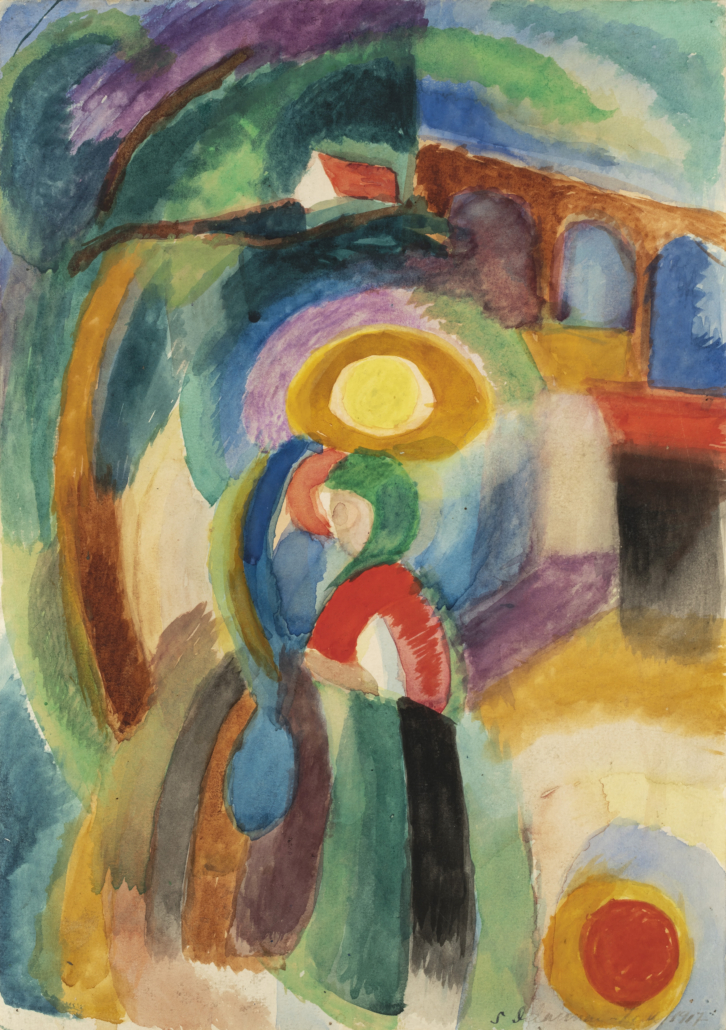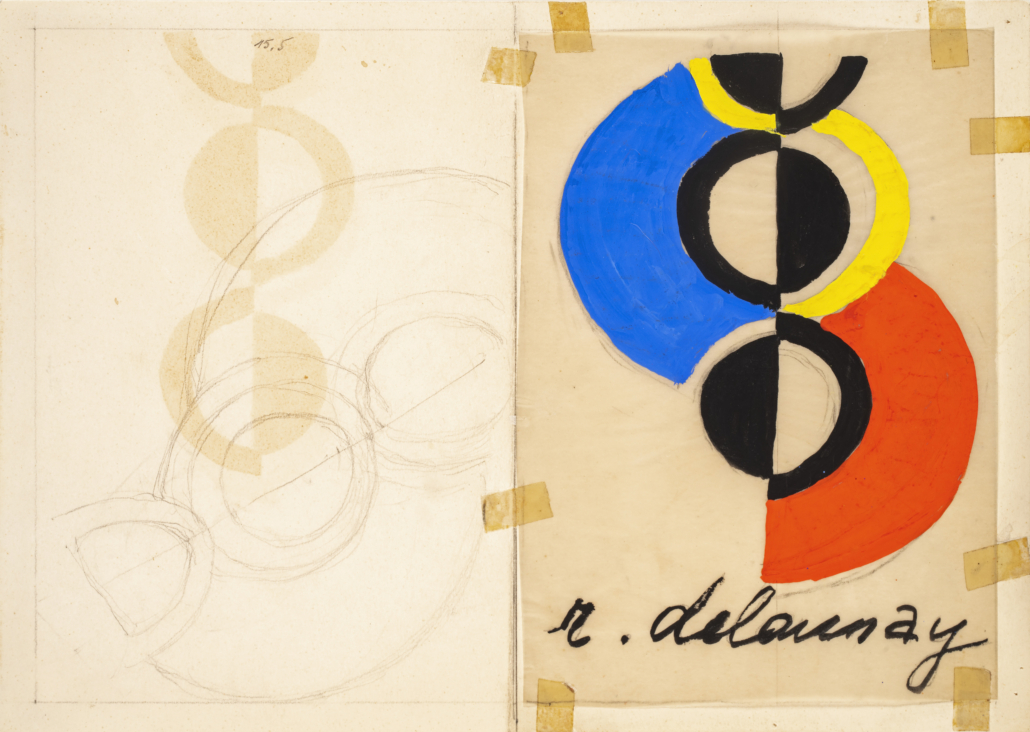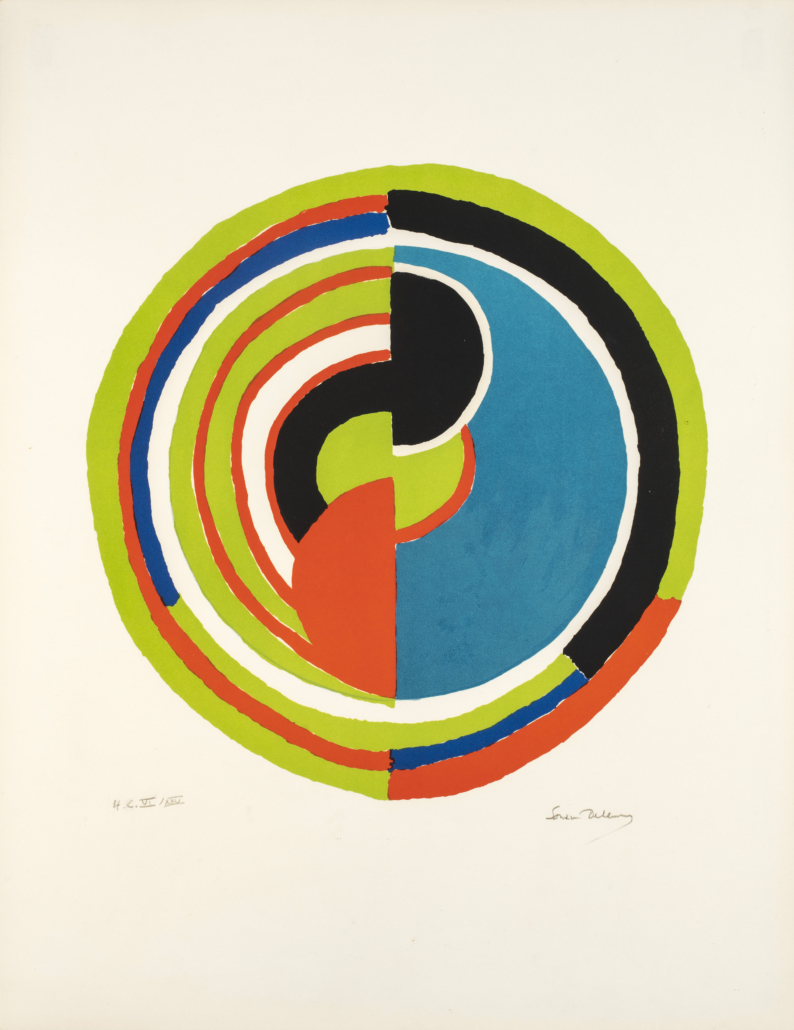Sonia Delaunay
The Simultaneous

Continuing its commitment to highlighting Sonia Delaunay after an exhibition in the spring of 2021 at the gallery, as well as a notable presentation at Art Basel in June 2023, Galerie Zlotowski presents Sonia Delaunay, la Simultanee, the third highlight dedicated to the pioneer of abstraction, who devoted 70 years of her life to her creations.
Abstract artist, fashion designer, design designer, graphic designer, successful entrepreneur, godmother of abstraction, explorer of mediums, Sonia Delaunay had, almost simultaneously, all these facets. This frenzy can be explained by a conception of art that goes beyond the traditional framework of drawing and canvas to conquer life itself. Sonia Delaunay has constantly abolished the boundaries between visual art and decorative art, while remaining faithful to the principles of “simultanism”, a conception of abstraction focused on the interaction of colours, which she developed with her husband Robert in the 1910s. The exhibition presents emblematic works of this colourful abstraction, recognisable among all, with works on paper and paintings on canvas (from 1907 to 1979, the year of the artist’s death). But Sonia Delaunay, la Simultanee ventures further, by showing pieces emblematic of this appetite for innovation and exploration, which makes the artist’s career so original: fashion drawings of course, but also book covers, tapestry projects, graphic design essays, lithographs and, even more unexpected, mosaics and playing card designs!

The first section of the exhibition focuses on the unparalleled collaboration that united Sonia and Robert Delaunay, who married in 1910. It shows the works of the Spanish and Portuguese stays (1914-1918), a blessed period for Sonia despite the tragic context of the war, made of meetings with local artists and intense work, inspired by the light of the Iberian Peninsula. The “simultaneism” of the 1910s does not reject figuration but extracts geometric shapes from bodies, faces or objects that organize color combinations. Beyond this ideal of creating as a duo, Robert and Sonia never ceased to support each other. While Sonia launched into the marketing of clothing in Paris in the early 1920s, Robert Delaunay executed a series of portraits of ladies dressed in Sonia Delaunay’s creations, as many tributes to his wife’s inventiveness in terms of fashion. Conversely, after Robert’s premature death in 1941, Sonia led a fierce fight to ensure that her husband found his rightful place as a pioneer in the history of abstraction that was then being written, organizing exhibitions, making donations to institutions and publishing numerous works.

The second part of the exhibition is devoted to drawings related to the fashion that dominated Sonia Delaunay’s work in the 1920s. It is titled after the poem by Blaise Cendrars, a dear friend of Sonia, On the dress she has a body (1913), the inversion of the body and the dress underlining the revolutionary character of the Delaunay style. This vision of a redefinition of fashion is confirmed by Guillaume Apollinaire’s comment, “You have to go see in Bullier, on Thursdays and Sundays, Mr. and Mrs. Robert Delaunay, painters, who are in the process of reforming the costume there.” It was certainly material reasons that pushed Sonia Delaunay to move from avant-garde and experimental clothing to the Haute Couture entrepreneurship that would impress even Gloria Swanson, the star of Cecil B. de Mille’s films at MGM. As she lost her income from her uncle’s properties with the Russian revolution of 1917, Sonia Delaunay became, in spite of herself, an entrepreneur by creating the Casa Sonia store in Madrid (1918) and then the Maison Sonia in Paris (1925). She would not stop designing textile patterns until late in her career, notably for the Dutch house Metz & Co. The Delaunays were strategists in order to assert their place in their time and demonstrate that they were stakeholders in the changes underway. Robert theorizes: “We see a simultaneous rising fashion wave that corresponds to a desire. Fabrics, advertisements, furniture are undeniably evolving towards living color.”

Sonia’s gouaches show that fashion, invested by “simultaneism”, is the coherent extension of an artistic conception connected to life. This frequentation of “less noble” arts will nevertheless cost Sonia Delaunay her place in the history of art for a time. However, more recent exhibitions have challenged this hierarchical and dated vision. A turnaround is palpable in the retrospective Les Couleurs de l’Abstraction at the Musée d’art Moderne de la Ville de Paris (2014) and at the Tate Gallery (2015), confirmed more recently with Sonia Delaunay at the Louisiana Museum in Copenhagen (2022) and Living Art at the Bard Graduate Center in New York (2024). All these exhibitions celebrate the audacious crossings of boundaries that characterize Sonia Delaunay’s career. Thanks to them, we realize that Sonia Delaunay has succeeded in creating a living and vibrant art that operates a convincing synthesis of simultaneist arts.

The third part of the exhibition focuses on Sonia Delaunay’s pictorial production in the post-war period. She is a rare case in the history of women artists in the 20th century who achieved success and recognition during her lifetime, albeit at an advanced stage in her career. Gradually, the “woman of Robert Delaunay” established herself, placing herself at the heart of the post-war avant-garde movements. In the 1960s and 1970s, major museum exhibitions highlighted her work: she was the first woman to exhibit during her lifetime at the Musée du Louvre in 1964. And three years later, in 1967-68, a major retrospective was devoted to her at the Musée d’Art Moderne. Within the exhibition, the work that embodies this renaissance is the large gouache Rythme couleur from 1961, shown in an exhibition at the innovative Galerie Denise René.

This piece is the original version of a stencil produced for this same exhibition. If its abstraction is geometric and always organized by color, the forms are free, rhythmic, never totally clear. Far from the exactitude of the contours typical of concrete art, for which the pictorial gesture must disappear and subjectivity dissolve, the very application of the flat areas of color is palpable, as if the artist were asserting her presence. This is a characteristic that applies to all of Sonia Delaunay’s work: her presence in the work. The trace of the hand that applies the color is obvious and color modifications are sometimes visible. The series of color rhythms from the 1970s presented here are therefore emblematic of this freedom, which results in a radical synthesis of forms, as if Sonia Delaunay were going to the limits of the possibilities of “simultaneity.” But this programmatic character of an abstraction pushed to its limits is combined with an assumed imperfection, which always recalls the “profession” of the artist and his hand in full action.

The last part of the exhibition is devoted to works that do not fall within the field of drawing or painting strictly speaking. These are playful and surprising projects, in which Sonia Delaunay ventured throughout her long career. The diversity of Sonia Delaunay’s production is astonishing. Publishing, poetry illustration, graphic design and advertising would fascinate her, to the point, for the latter field, of carrying out projects not requested by the company for which she was “advertising”. The significant production of projects linked to publications would begin very early, with the catalog cover projects of 1916, then that for the famous Album n°1 (1916) and the magazine Ararat (1917).

Sonia’s inclination towards more accessible and visible media also responds to her desire to collaborate with her allies and friends. Illustration or fashion allow her to connect with poets she admires and loves deeply, such as Blaise Cendrars or Tristan Tzara. And to attach herself to them, what could be simpler than illustrating or dressing them? This need for proximity, for cooperation with chosen beings, by affinities and affection, is the common thread of all the “off-limits” initiatives that Sonia Delaunay undertakes, as her feelings guide her production.

Sonia remained active until her last breath in December 1979. Her last gouaches are striking. She had never been so fully present in them. We can see the trembling of the old lady’s hand in the outline of the squares of this checkerboard, from the collection of Jacques Damasse, executed in 1979. The black seems to want to invade the other colours which, for once, seem on the point of being absent…


